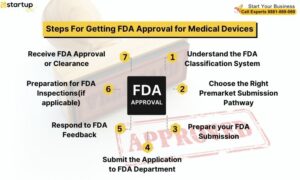Having US FDA Certification is crucial for medical device manufacturers to enter into the US market. Let’s learn how to get FDA Approval for Medical Devices in India through this article.
Step 1: Understand the FDA Classification System
Before getting FDA Approval, you must understand the FDA Classification system which is divided into three classes.
Class 1
These are low-risk devices such as surgical gloves and manual stethoscopes. These items are generally exempt from premarket notification requirements.
Class 2
These are moderate-risk devices and generally require a 510(k) premarket notification to demonstrate substantial equivalence to an existing approved device.
Class 3
These are high-risk devices and require premarket approval, which involves a more rigorous review process.
Step 2: Choose the Right Premarket Submission Pathway
The available pathway for FDA Medical Device Registration or approval are as follows:
- 510(k) Premarket Notification
The most common pathway for Class 2 devices and some Class 1 devices is 510(k). To get this you need to demonstrate that your device is substantially equivalent to a legally marketed device in the US.
- Premarket Approval(PMA)
It is required for most of the Class 3 devices that have low to moderate risk but lack a predicate device. It also provides a new market to new devices that won’t need premarket approval.
- De Novo Classification Request
It is for novel devices that present low to moderate risk but do not have a predicate device. Thus, providing a route to a market for new devices without needing a PMA.
- Exempt Devices
Some class 1 and class 2 devices are exempt from getting premarket notification but it also requires compliance with FDA Regulations and US FDA Registration.
Step 3: Prepare your FDA Submission
Detailed FDA Submission helps in easy and quick FDA Approval. This includes:
- Device Description: Provides detailed information on your device’s design, materials, and intended purpose.
- Labelling and Use Instructions: Drafts of all FDA-compliant labels, packaging, and user manuals.
- Bench testing, animal studies, and clinical trials (if appropriate) are used to demonstrate your device’s safety and efficacy.
- Risk Analysis and Mitigation Strategies: A document outlining possible hazards and the methods taken to minimise them.
Step 4: Submit the Application to FDA Department
After completing the steps above, you will need to submit the application to the FDA. You can do it through the eCopy Program. You must also pay the fees depending on a number of factors such as submission type and your company’s size. After receiving your application, FDA will provide acknowledgement and that means the review process has begun. If you need any assistance or feel any confusion in any step, you can take help from E-StartupIndia’s experts in FDA Medical Device Registration.
Learn More: How to verify US FDA Certification?
Step 5: Respond to FDA Feedback
You may be asked multiple questions or asked for additional information. Thus, it is crucial for you to make these requests promptly and correctly. Don’t take any risk in this step as any mistake can also result in rejection.
Step 6: Preparation for FDA Inspections(if applicable)
For some devices, particularly those requiring a PMA, the FDA may audit your production plant to check compliance with regulatory standards. Here you need to prepare for an inspection by keeping detailed documentation and verifying that all production procedures follow FDA rules.
Step 7: Receive FDA Approval or Clearance
Once your Inspection is done by the FDA, you will receive either a clearance letter (concerning 510(k) submissions) or an approval letter (concerning PMA submissions). Thus, after the approval from FDA, you get FDA Certification that allows you to sell your product on the territory of the United States. Please keep in mind any requirements for or conditions attached to any postmarketing surveillance that may have been given to you with your clearance.
To get US FDA certification in India, you will need to follow the simple steps above which are to classify the device, choose the correct pathway (510(k), PMA, De Novo), prepare and submit the required documentation to the FDA, and respond to any feedback for final approval. The best way to get FDA Approval for Medical devices is through hiring FDA Certification experts.

FAQs
How Much Does It Cost to Get FDA Approval for a Medical Device?
The cost of FDA certification may depend on the type of submission and company size. For your specific application, you can get cost estimation by calling: 8881-069-069.
What Are the Pathways for Medical Device Approval?
The pathways for Medical Device Approval include 510(k), Premarket Approval (PMA), De Novo, and Exemptions for low-risk devices.
What Are the Four Phases of FDA Approval for Medical Devices?
The four phases are Classification, Pre-Submission, Submission & Review, and Post-Market Compliance, essential steps in completing FDA Certification in India.
Can Medical Devices Be Used Without FDA Approval?
In general, Most medical devices require FDA Medical Device Registration unless the medical devices are low-risk Class I exemptions.
How Long Does It Take to Get a Medical Device Approved?
Approval timelines vary: 510(k) takes 3-6 months, PMA can take 1-3 years, and De Novo typically requires 6-12 months for US FDA certification.
If you want any other guidance relating to the US FDA Certification, please feel free to talk to our business advisors at 8881-069-069.
Download E-Startup Mobile App and Never miss the latest updates narrating to your business.
